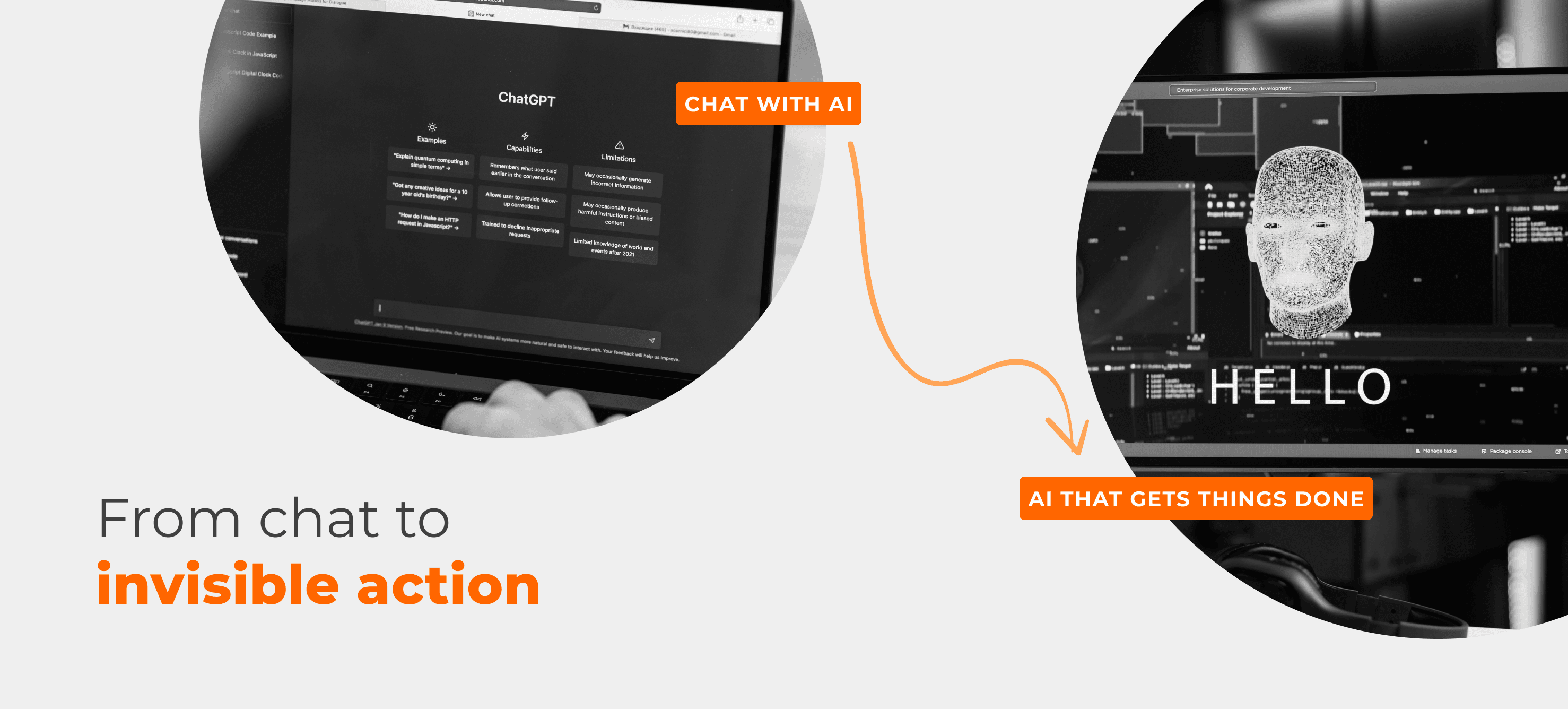The Evolution of AI Interfaces: From Talking to Solving

We are living through a paradigm shift in how we interact with artificial intelligence. While the last decade was marked by the rise of chatbots and conversational virtual assistants, a more subtle yet profound revolution is taking place behind the scenes of the digital experience. The new AI interfaces do not announce themselves with chat bubbles or command prompts, they simply act, anticipate, and resolve.
This change represents a natural evolution in human-computer interaction design, where efficiency outweighs explicitness, and where AI becomes truly ubiquitous by integrating seamlessly into existing workflows. The future of AI is not about making machines better conversationalists, but about enabling them to understand our intentions before we even articulate them fully.

An Alternative to the Conversational Model
For years, the tech industry heavily invested in building virtual assistants that simulated human conversation. Alexa, Siri, Google Assistant, and more recently, ChatGPT, established a collective mental model that AI is accessed through structured dialogue. However, this approach, while useful to end users, is not always the best fit.
The conversational interface, by its nature, introduces cognitive friction. It requires the user to formulate precise questions, wait for responses, and often rephrase requests to achieve the desired outcome. While helpful and intuitive in certain contexts, this process becomes inadequate for the routine, specific, and contextualized tasks that make up most of our interactions with digital systems.
Micro Assistants: Contextual Intelligence in Action
The new generation of AI interfaces manifests through micro assistants, systems that operate quietly within the applications we already use, offering context-based suggestions and automations without interrupting the natural workflow or requiring a chat session with the user.
These systems represent a significant leap from conversational assistants, as they incorporate not only natural language processing but also deep contextual understanding and behavioral anticipation.
In Gmail, for example, the Smart Compose feature doesn’t wait for the user to ask for help, it continuously analyzes the text being typed, the communication history, and the conversation context to suggest sentence completions that maintain stylistic and semantic consistency.
On LinkedIn, with a single click, AI rewrites posts for better engagement, no chat required, no need for the user to provide context.
This approach reflects a fundamental shift in design philosophy: instead of waiting for explicit commands, AI observes, learns, and acts proactively. The result is a truly assistive experience, reducing cognitive load instead of adding another layer of interaction.
Integrated Co-pilots: Efficiency Through Contextualization
Beyond micro assistants, we now see the rise of specialized co-pilots, AI systems deeply integrated into specific workflows to deliver highly contextualized support. Unlike generic chatbots, these systems are built with a deep understanding of organizational processes and sector-specific nuances.
A practical example can be found in customer service teams working on Reclame Aqui. Instead of offering a generic chat, the system automatically analyzes each complaint’s context, including customer history, issue type, applicable corporate policies, and past resolutions, then provides three pre-structured response options. Each option is calibrated not only to resolve the specific issue but also to maintain brand voice and comply with regulatory guidelines.
The impact on productivity is exponential. Customer service agents who previously had to navigate multiple systems, consult manuals, and draft responses from scratch can now resolve complex cases in a fraction of the time. Even more importantly, the quality and consistency of responses improve significantly, as each suggestion is based on algorithmic analysis of best practices and historical outcomes.
The Voice Interface Revolution
In parallel with micro assistants and contextual co-pilots, voice interfaces are emerging as the next evolutionary leap in frictionless interaction. Unlike traditional voice commands, which still require explicit activation and structured phrasing, new voice AI implementations operate through continuous processing and advanced contextual interpretation.
This technology promises to completely eliminate the need for traditional physical interfaces, taps, clicks, hierarchical navigation, replacing them with natural, fluid interaction. The concept of “zero friction, 100% presence” envisions technology so seamlessly integrated into the environment that its operation feels like thought materialized.
Imagine a professional environment where saying, “I need to review the quarterly numbers,” automatically triggers the compilation of relevant data, report formatting, and scheduling of related meetings, based on contextual understanding of calendars, ongoing projects, and historical work patterns. This is not science fiction but a logical extension of capabilities already demonstrated by today’s micro assistants.
Technical and Architectural Implications
This transition from conversational interfaces to contextual assistive systems demands fundamentally different technological architectures. Instead of centralized models that process discrete requests, new implementations require distributed systems capable of continuous processing, real-time contextual analysis, and autonomous decision-making within defined parameters.
Adaptive machine learning becomes crucial, as these systems must continuously learn from both individual and collective patterns without compromising privacy or security. Edge computing gains added relevance, enabling local processing that reduces latency and keeps sensitive data under user control.
Deep integration with existing APIs and legacy systems also becomes imperative, since the value of these micro assistants and co-pilots depends directly on their ability to operate harmoniously within established technological ecosystems.
Conclusion
We are witnessing a subtle but profound transformation in how artificial intelligence integrates into human experience. The future of AI does not lie in more sophisticated conversations, but in smarter understanding and action. Micro assistants, contextual co-pilots, and voice interfaces represent only the beginning of an era where technology becomes truly ubiquitous, present, useful, and powerful, yet invisible.
This evolution promises not only greater efficiency but also a fundamental reconfiguration of the human-technology relationship. Instead of users operating systems, we become collaborators in intelligent ecosystems that amplify human capabilities in ways previously unimaginable.
